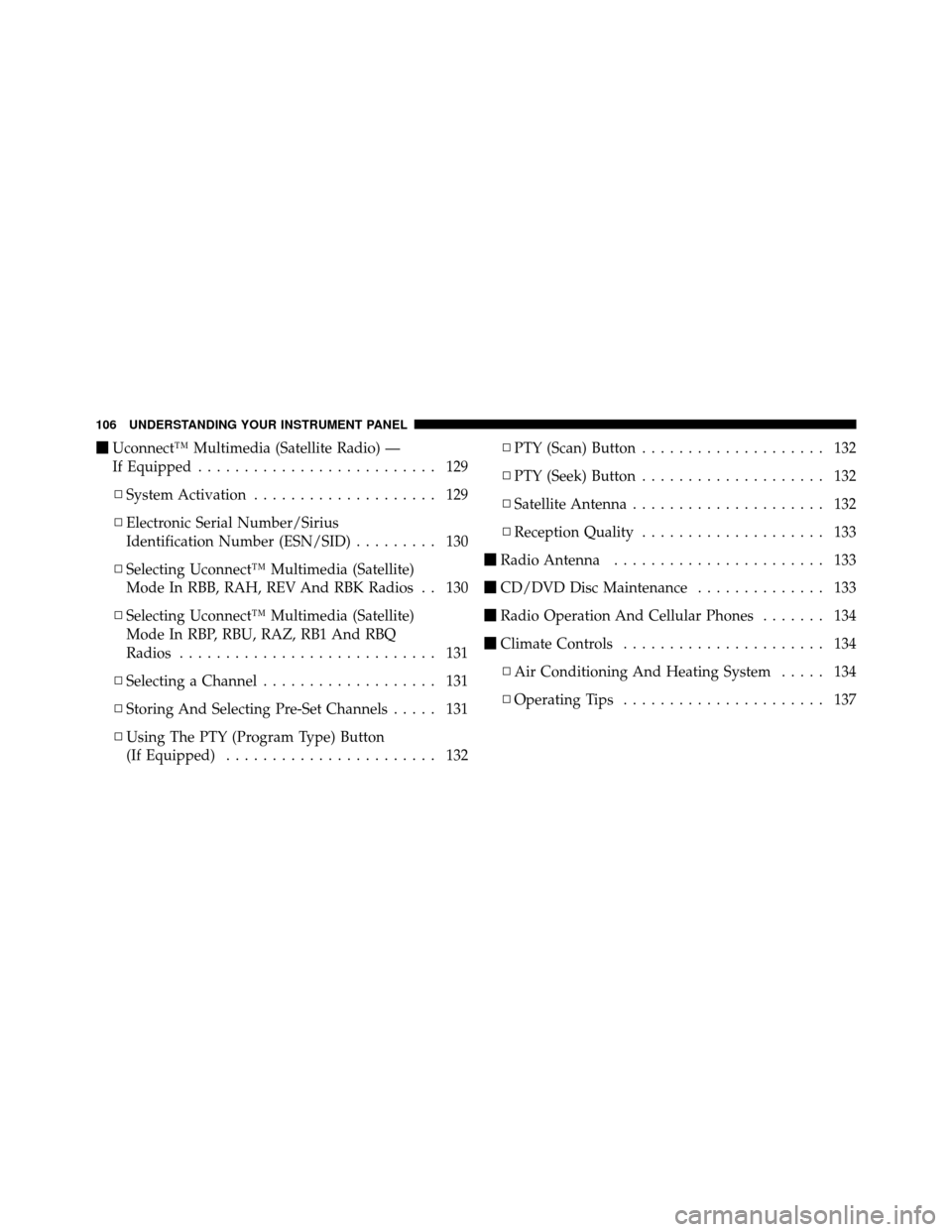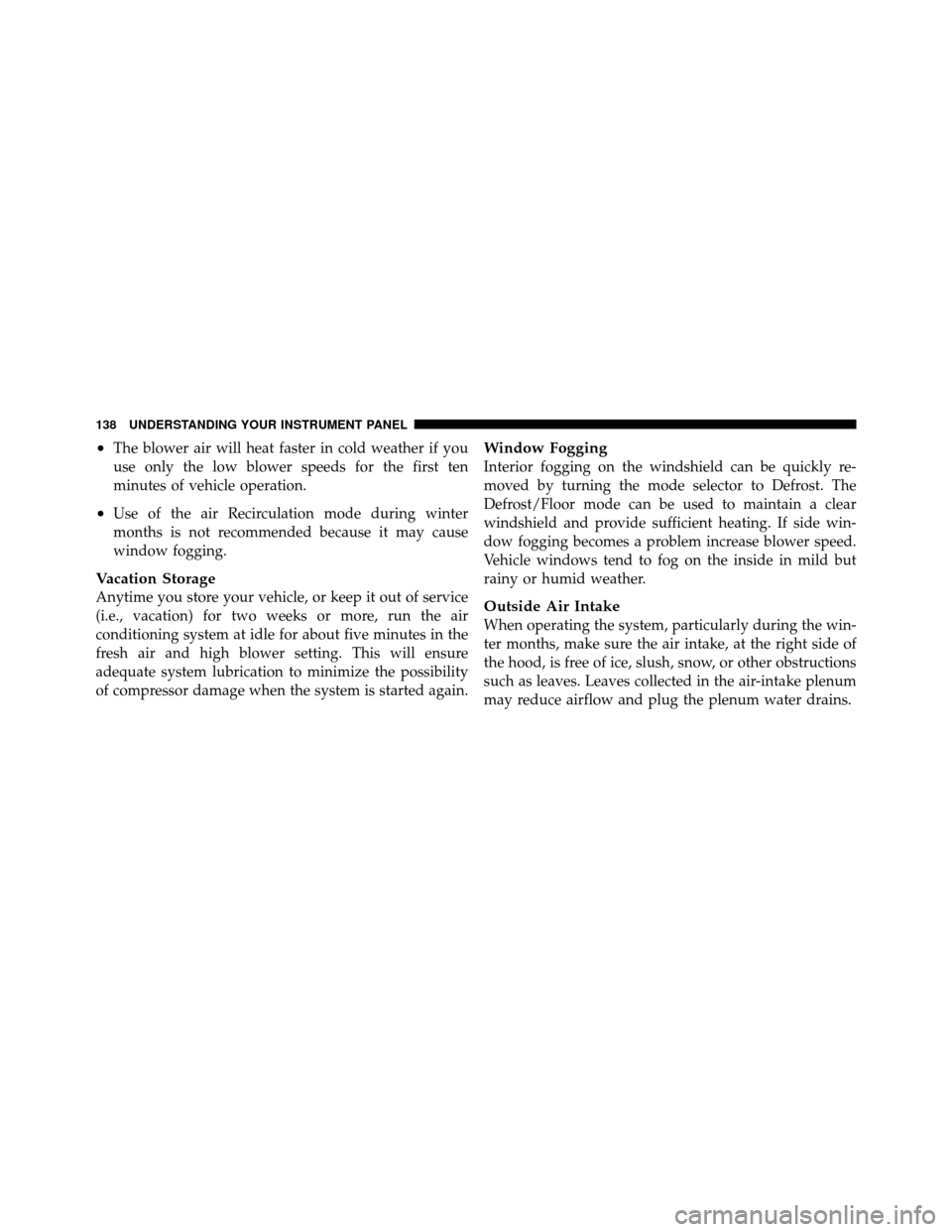Page 110 of 315

�Uconnect™ Multimedia (Satellite Radio) —
If Equipped .......................... 129
▫ System Activation .................... 129
▫ Electronic Serial Number/Sirius
Identification Number (ESN/SID) ......... 130
▫ Selecting Uconnect™ Multimedia (Satellite)
Mode In RBB, RAH, REV And RBK Radios . . 130
▫ Selecting Uconnect™ Multimedia (Satellite)
Mode In RBP, RBU, RAZ, RB1 And RBQ
Radios ............................ 131
▫ Selecting a Channel ................... 131
▫ Storing And Selecting Pre-Set Channels ..... 131
▫ Using The PTY (Program Type) Button
(If Equipped) ....................... 132 ▫
PTY (Scan) Button .................... 132
▫ PTY (Seek) Button .................... 132
▫ Satellite Antenna ..................... 132
▫ Reception Quality .................... 133
� Radio Antenna ....................... 133
� CD/DVD Disc Maintenance .............. 133
� Radio Operation And Cellular Phones ....... 134
� Climate Controls ...................... 134
▫ Air Conditioning And Heating System ..... 134
▫ Operating Tips ...................... 137
106 UNDERSTANDING YOUR INSTRUMENT PANEL
Page 138 of 315
NOTE:If you experience difficulty in playing a particu-
lar disc, it may be damaged (i.e., scratched, reflective
coating removed, a hair, moisture or dew on the disc)
oversized, or have protection encoding. Try a known
good disc before considering disc player service.
RADIO OPERATION AND CELLULAR PHONES
Under certain conditions, the cellular phone being on in
your vehicle can cause erratic or noisy performance from
your radio. This condition may be lessened or eliminated
by relocating the cellular phone antenna. This condition
is not harmful to the radio. If your radio performance
does not satisfactorily “clear” by the repositioning of the
antenna, it is recommended that the radio volume be
turned down or off during cellular phone operation.
CLIMATE CONTROLS
The Air Conditioning and Heating System is designed to
make you comfortable in all types of weather.
Air Conditioning and Heating System
Air Conditioning And Heater Controls
134 UNDERSTANDING YOUR INSTRUMENT PANEL
Page 141 of 315

NOTE:The air conditioning compressor operates in this
mode. This dehumidifies the air to help dry the wind-
shield. To improve fuel economy, leave in the Defrost
mode only when necessary.
Air Conditioning Control
With the fan control in the ON position, push the
A/C button to turn on the air conditioning com-
pressor. An indicator light above the button shows
that the Air Conditioning compressor is on. Conditioned
air is now directed through the outlets selected. Pushing
the button a second time turns the compressor OFF.
Slight changes in engine speed or power may be noticed
when the compressor is on. This is a normal occurrence
since the compressor will cycle on and off to maintain
comfort and increase fuel economy.
NOTE: If your air conditioning performance seems
lower than expected, check the front of the A/C con-
denser for an accumulation of dirt or insects.
Operating Tips
NOTE: Refer to the chart at the end of this section for
suggested control settings for various weather condi-
tions.
Summer Operation
The engine cooling system in air-conditioned vehicles
must be protected with a high-quality antifreeze coolant
to provide proper corrosion protection and to protect
against engine overheating. A solution of 50% ethylene
glycol antifreeze coolant and 50% water is recommended.
Refer to “Maintenance Procedures” in “Maintaining Your
Vehicle” for proper coolant selection.
Winter Operation
•
Use the Defrost mode to direct cold air away from the
occupants during engine warm-up in cold weather.
4
UNDERSTANDING YOUR INSTRUMENT PANEL 137
Page 142 of 315

•The blower air will heat faster in cold weather if you
use only the low blower speeds for the first ten
minutes of vehicle operation.
•Use of the air Recirculation mode during winter
months is not recommended because it may cause
window fogging.
Vacation Storage
Anytime you store your vehicle, or keep it out of service
(i.e., vacation) for two weeks or more, run the air
conditioning system at idle for about five minutes in the
fresh air and high blower setting. This will ensure
adequate system lubrication to minimize the possibility
of compressor damage when the system is started again.
Window Fogging
Interior fogging on the windshield can be quickly re-
moved by turning the mode selector to Defrost. The
Defrost/Floor mode can be used to maintain a clear
windshield and provide sufficient heating. If side win-
dow fogging becomes a problem increase blower speed.
Vehicle windows tend to fog on the inside in mild but
rainy or humid weather.
Outside Air Intake
When operating the system, particularly during the win-
ter months, make sure the air intake, at the right side of
the hood, is free of ice, slush, snow, or other obstructions
such as leaves. Leaves collected in the air-intake plenum
may reduce airflow and plug the plenum water drains.
138 UNDERSTANDING YOUR INSTRUMENT PANEL
Page 225 of 315

•The Vehicle Security Alarm is disabled when the
Battery Save Feature is enabled. Therefore, the vehicle
is not protected when the Battery Save Feature is
enabled.
•The exterior and interior lighting functions will not
work when the Battery Save Feature is enabled.
To Deactivate the Battery Save Feature
1. Press the exterior driver’s door handle once to wake
up the vehicle. Then, press the handle again to open the
door.
NOTE:If the door does not open (vehicle is armed),
press the RKE UNLOCK button to unlock the vehicle.
2. Insert the key into the ignition switch.
3. Turn the ignition switch to the ON/RUN position. The
Battery Save Feature will turn off. NOTE:
If the ignition switch is NOT turned to ON/
RUN position, the Battery Save Feature will be enabled
45 seconds after the driver’s door is closed.
Air Conditioner Maintenance
For best possible performance, your air conditioner
should be checked and serviced by an authorized dealer
at the start of each warm season. This service should
include cleaning of the condenser fins and a performance
test. Drive belt tension should also be checked at this
time.
CAUTION!
Do not use chemical flushes in your air conditioning
system as the chemicals can damage your air condi-
tioning components. Such damage is not covered by
the New Vehicle Limited Warranty.7
MAINTAINING YOUR VEHICLE 221
Page 226 of 315

NOTE:If A/C performance seems less then normal,
check the front of the A/C condenser (located in front of
the radiator) for dirt and insect accumulation. Clean with
a gentle water spray as required. Front end fascia protec-
tors may reduce air flow to the condenser and radiator,
reducing A/C and engine cooling performance.
WARNING!
•Use only refrigerants and compressor lubricants
approved by the manufacturer for your air condi-
tioning system. Some unapproved refrigerants are
flammable and can explode, injuring you. Other
unapproved refrigerants or lubricants can cause
the system to fail, requiring costly repairs. Refer to
Warranty Information Book, located on the DVD,
for further warranty information.
(Continued)
WARNING! (Continued)
•The air conditioning system contains refrigerant
under high pressure. To avoid risk of personal
injury or damage to the system, adding refrigerant
or any repair requiring lines to be disconnected
should be done by an experienced technician.
Refrigerant Recovery and Recycling
R-134a Air Conditioning Refrigerant is a hydrofluoro-
carbon (HFC) that is endorsed by the Environmental
Protection Agency and is an ozone-saving product. How-
ever, the manufacturer recommends that air conditioning
service be performed by authorized dealers or other
service facilities using recovery and recycling equipment.
NOTE:Use only manufacturer approved A/C System
Sealers, Stop Leak Products, Seal Conditioners, Compres-
sor Oil, and Refrigerants.
222 MAINTAINING YOUR VEHICLE
Page 236 of 315

If an examination of your engine compartment shows no
evidence of radiator or hose leaks, the vehicle may be
safely driven. The vapor will soon dissipate.
•Do not overfill the coolant recovery bottle.
•Check engine coolant (antifreeze) freeze point in the
coolant bottle. If engine coolant (antifreeze) needs to
be added, contents of the coolant bottle also must be
protected against freezing.
•If frequent engine coolant (antifreeze) additions are
required, or if the level in the coolant recovery bottle
does not drop when the engine cools, the cooling
system should be pressure tested for leaks.
•Maintain engine coolant (antifreeze) concentration at
50% HOAT engine coolant (antifreeze) (minimum)
and distilled water for proper corrosion protection of
your engine, which contains aluminum components.
•Make sure that the radiator and coolant recovery
bottle overflow hoses are not kinked or obstructed.
•Keep the front of the radiator clean. If your vehicle is
equipped with air conditioning, keep the front of the
condenser clean.
•Do not change the thermostat for Summer or Winter
operation. If replacement is ever necessary, install
ONLY the correct type thermostat. Other designs may
result in unsatisfactory cooling performance, poor gas
mileage, and increased emissions.
Brake System
In order to assure brake system performance, all brake
system components should be inspected periodically.
Refer to “Maintenance Schedule” for the proper mainte-
nance intervals.
232 MAINTAINING YOUR VEHICLE
Page 249 of 315
Cavity Car-tridge
Fuse Mini-
Fuse
Description
8 30 Amp Pink — Ignition Switch Run/
Accessory Feed
9 40 Amp Green — Headlights
10 30 Amp Pink — Ignition Switch Run Feed
11 — 20 Amp YellowAuto Shutdown Relay
(ASD)
12 — 20 Amp YellowCigar Lighter
13 — 15 Amp BlueHazard Flasher
14 — 20 Amp YellowAuto Shutdown Relay
(ASD)
15 — 25 Amp ClearRear Window Defogger
(EBL)Cavity Car-
tridge
Fuse Mini-
Fuse
Description
16, 17 — 20 Amp YellowPower Outlet
18 — 15 Amp BlueIgnition Off Draw (IOD)
19 — 15 Amp BlueHorn
20 — 15 Amp BlueAir Conditioning (A/C)
Clutch Relay
21 — 15 Amp BlueStop Light Switch
22 — 25 Amp ClearFuel Pump/Powertrain
Control Module (PCM)
23, 24 — 10 Amp RedAirbag
60, 61 — 15 Amp BlueIgnition Run/Start Relay
Feed
7
MAINTAINING YOUR VEHICLE 245